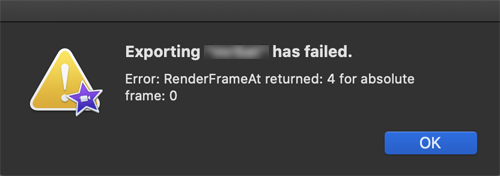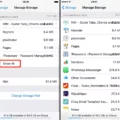IMovie is a popular video editing software used by many Mac users. It offers a range of features and tools that allow users to create and edit professional-looking videos. However, like any software, iMovie is not immune to errors and glitches. One common error that users may encounter is the “iMovie not exporting full movie” error.
This error occurs when you try to export your iMovie project, but the exported file is incomplete or missing certain parts of the movie. This can be frustrating, especially if you’ve spent a lot of time and effort creating your video.
There are several possible causes for this error. One of the most common reasons is the presence of a corrupted clip in your iMovie project. A corrupted clip can disrupt the export process and cause the software to skip or omit certain parts of the movie.
To fix this issue, one solution is to copy-paste all the video clips from your current iMovie project into a new project. This will help isolate and remove any corrupted clips that may be causing the error. Once you’ve created a new project, try exporting it again and see if the error persists.
Another option is to manually locate and replace the corrupted clip in your iMovie project. To do this, carefully review your project timeline and look for any clips that may appear distorted or cause playback issues. Once you’ve identified the corrupted clip, remove it from your project and replace it with a different clip. Then, try exporting your project again and see if the error is resolved.
In addition to corrupted clips, other factors can also contribute to the “iMovie not exporting full movie” error. For example, insufficient storage space on your Mac device can prevent iMovie from exporting the entire video. Make sure you have enough free space on your computer before attempting to export your project.
Additionally, check that you have selected the correct export file format and name. Sometimes, a simple oversight in the export settings can cause the error. Double-check your export settings to ensure they are correct.
If none of these solutions work, it’s possible that your iMovie project file itself is corrupted. In this case, you may need to consider starting a new project and re-creating your video from scratch. It’s always a good idea to regularly save and back up your iMovie projects to prevent the loss of valuable work.
The “iMovie not exporting full movie” error can be frustrating, but there are several potential solutions. By copying your clips to a new project, replacing corrupted clips, checking storage space, and reviewing export settings, you can troubleshoot and resolve this issue. Remember to save and back up your projects regularly to prevent data loss.

How Do You Fix Errors in iMovie?
To fix errors in iMovie, you can follow these steps:
1. Update iMovie: Ensure that you have the latest version of iMovie installed on your device. Updating the software can often resolve common issues.
2. Restart iMovie: Close iMovie completely and then reopen it. Sometimes, a simple restart can resolve minor glitches or temporary errors.
3. Check system requirements: Verify that your device meets the minimum system requirements for running iMovie. Inadequate system specifications can cause performance issues and errors.
4. Check project file location: Make sure that your iMovie project file is stored in a location with sufficient storage space and proper file permissions. If the storage is full or the file is inaccessible, it can lead to errors.
5. Repair disk permissions: If you are using a Mac, you can repair disk permissions using the Disk Utility tool. This can help fix any file permission issues that might be causing errors in iMovie.
6. Delete cache files: Clearing iMovie’s cache files can sometimes resolve errors. Navigate to the Library folder on your device, locate the iMovie folder, and delete any cache or temporary files associated with iMovie.
7. Remove unsupported media files: If you have imported media files that are not compatible with iMovie, such as unsupported video formats or codecs, remove them from your project. Use compatible file types to avoid compatibility issues.
8. Split long projects: If you are working on a large and complex project, consider splitting it into smaller segments. This can help reduce processing load and prevent errors.
9. Reinstall iMovie: If none of the above steps resolve the issue, you may need to uninstall and reinstall iMovie. Ensure that you have a backup of your projects before doing so.
10. Contact Apple Support: If the problem persists, you can reach out to Apple Support for further assistance. They can provide specific troubleshooting steps based on your situation.
Remember to save your work regularly and create backups of your projects to minimize the risk of losing data due to errors.
Why is iMovie Saying An Error Occurred During Export?
IMovie may display an error message during export for several reasons. It is important to understand these potential causes to troubleshoot the issue effectively. Here are some possible reasons why iMovie is reporting an error during export:
1. Insufficient Storage Space: One common reason for export failure is the lack of available storage space on your Mac device. When exporting a movie, iMovie requires enough space to generate the final video file. If your computer’s storage is nearly full, it can lead to export errors. Ensure that you have enough free space on your device before attempting to export the movie.
2. Corrupted Project: If your iMovie project file is damaged or corrupted, it can cause export errors. This can happen due to various reasons, such as unexpected power loss, software glitches, or improper project handling. To resolve this issue, try creating a new project and importing the media files from the problematic project. If the export works in the new project, it indicates that the original project file was indeed corrupted.
3. Large File Size: If your movie project contains numerous high-resolution videos, images, or effects, it can result in a large file size. Exporting such large files may exceed the limitations of your system resources, leading to export errors. To address this, you can try reducing the project’s file size by compressing or optimizing the media files and removing any unnecessary elements.
4. Export File Name Issues: Sometimes, the export failure can occur due to problems with the file name you choose for the exported movie. Ensure that the file name does not contain any special characters, symbols, or spaces. Stick to alphanumeric characters and use underscores or hyphens if necessary. Also, make sure the chosen file name is within the acceptable length limits imposed by your operating system.
5. Software Compatibility: In some cases, iMovie export errors may occur due to compatibility issues with your system’s software or operating system. Check if you are using the latest version of iMovie and ensure that it is compatible with your macOS version. Updating iMovie or your operating system might address any compatibility issues you are facing.
To summarize, iMovie may report errors during export due to insufficient storage space, corrupted project files, large file sizes, export file name issues, or software compatibility problems. By considering these potential causes and following the suggested solutions, you can troubleshoot the issue and successfully export your movie in iMovie.
What is iMovie Error 260?
IMovie error 260 is a specific error code that occurs in the iMovie app for iOS. This error is known as a “Cocoa error” and indicates an issue with incompatible files in your iMovie project.
When you encounter error 260, it means that there are duplicate files or elements within your iMovie project that are causing conflicts and preventing the project from being exported or saved successfully. These duplicate files can be any type of media files, such as video clips, images, or audio files.
To resolve this error, you need to identify and remove the problematic files or elements from your iMovie project. Follow the steps below to troubleshoot and fix the error:
1. Duplicate your iMovie project: Before making any changes, it’s always a good idea to create a backup of your project. This way, you can revert back to the original if needed.
2. Remove one thing at a time: Start by removing one file or element from your project at a time. This includes video clips, images, and audio files. After removing each element, try exporting or saving the project again to check if the error is resolved. Repeat this process until you identify the specific file causing the error.
3. Pay attention to audio files: In some cases, the error may be related to audio files in your iMovie project. Make sure to check and remove any duplicate or incompatible audio files as well. Sometimes, even a small audio glitch can trigger the error.
4. Test the project after each removal: After removing a file or element, always test the project by exporting or saving it. This will help you pinpoint the exact file causing the error and ensure that the project is still functioning as desired.
5. Repeat until the error is resolved: Continue removing files or elements one by one and testing the project until the error 260 no longer occurs. This process may take some time depending on the complexity of your project.
By following these steps, you should be able to identify and resolve the iMovie error 260. Remember to save your progress frequently and keep a backup of your project to avoid losing any important work.
How Do You Fix Error 10004 in iMovie?
To fix error code 10004 in iMovie, which indicates corruption in the project, you will need to follow a two-step process: repairing the corrupted videos and merging them into your project. Here are the detailed steps you can take to resolve this issue:
1. Repair the corrupted videos:
– Identify the specific videos that are causing the corruption in your iMovie project.
– Open the corrupted video files using a video repair tool or software. There are several third-party applications available for this purpose.
– Follow the instructions provided by the repair tool to fix the corrupted videos. This process usually involves scanning and repairing any errors or issues within the video files.
– Once the repair process is complete, ensure that the videos are playing properly and are no longer corrupted.
2. Merge the repaired videos into your iMovie project:
– Launch iMovie on your computer and open the project in which you want to include the repaired videos.
– Locate the repaired videos in your file system.
– Drag and drop the repaired videos from their location into the iMovie project timeline or event browser.
– If needed, rearrange the videos in the desired order within the project timeline.
– Save your iMovie project to ensure all changes are retained.
By following these steps, you should be able to resolve error code 10004 in iMovie. Remember to always keep backups of your video files and projects to avoid any data loss during the repair process.
Conclusion
iMovie errors can be frustrating and can hinder the smooth process of exporting your movies. However, by understanding the various error codes and their possible causes, you can effectively troubleshoot and resolve these issues.
The “iMovie not exporting full movie” error can be fixed by identifying and removing any corrupted clips from your project. This can be done by either copying and pasting all the video clips into a new iMovie project or by locating the corrupted clip and replacing it with another clip.
On the other hand, the “iMovie export failed” error can occur due to a lack of storage space on your device. It is important to ensure that you have enough available storage space before attempting to export your movie.
Lastly, the “iMovie for iOS Cocoa Error 260” and “iMovie export error code 10004” both indicate issues with incompatible or corrupted files in your project. To fix these errors, you can duplicate your iMovie project and gradually remove files, including audio files, to identify the problematic ones.
By following these solutions, you can overcome iMovie errors and successfully export your movies without any interruptions. Remember to always keep your iMovie project and files organized and regularly check for any issues to ensure a smooth and hassle-free movie-making experience.








